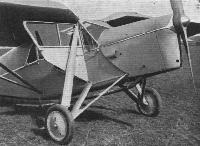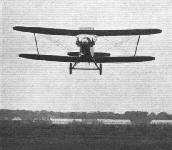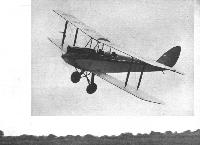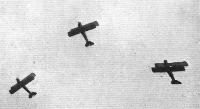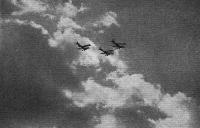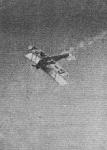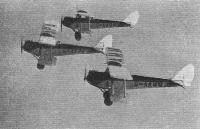Фотографии
-
Регистрационный номер: X216H [3] View from above of the Northrop Monoplane. This photograph shows the machine fitted with tractor airscrew.
Самолёты на фотографии: Northrop Avion 1 - США - 1929
-
Регистрационный номер: X216H [3] The Northrop "All-Wing" monoplane (pusher version) in flight. One cockpit covered in.
Самолёты на фотографии: Northrop Avion 1 - США - 1929
-
Регистрационный номер: X216H [3] THE NORTHROP "ALL-WING" MONOPLANE: This front view of the "pusher" version illustrates very clearly the tapering of the thick centre-section into the wings proper, and also shows the three-wheeled undercarriage.
Самолёты на фотографии: Northrop Avion 1 - США - 1929
-
"PEACEFUL PENETRATION": One of the latest Junkers type F.13 monoplanes has been registered in this country, and is now on a tour. Of the same general type as the famous "Bremen," this machine has a Junkers L.5 engine and seating accommodation for four passengers. It is intended for use by the wealthier class of private owner, or for air taxi work.
Самолёты на фотографии: Junkers F 13 - Германия - 1919
-
Регистрационный номер: G-AAGU Самолёты на фотографии: Junkers F 13 - Германия - 1919
-
THAT GENTLE TOUCH: Miss Slade puts her Moth down at Desford, but the wind nearly takes it off again for her.
Самолёты на фотографии: De Havilland Moth / D.H.60 - Великобритания - 1925
-
FOR THE IRISH FREE STATE: A most successful acceptance test flight has been accomplished with the first Vickers "Vespa IV." Army Co-operation aircraft, fitted with an Armstrong-Siddeley "Jaguar IVc" engine shown here, for the Army Air Corps of the Irish Free State. The performance put up by the machine was 135 m.p.h. at 15,000 ft.
Самолёты на фотографии: Vickers Vespa / Type 113 - Великобритания - 1925
-
Самолёты на фотографии: Parnall Elf - Великобритания - 1929
-
Регистрационный номер: G-AALA THE AUTOGIRO: The Auto giro is now to be seen at nearly all the flying meetings, and never fails to create great interest.
Самолёты на фотографии: Cierva/Avro C.19 - Великобритания - 1929
-
Регистрационный номер: G-AAIT Phoenix II, G-AAIT, at Mousehold, where it served as the company's own aircraft.
Самолёты на фотографии: Boulton Paul Phoenix / P.41 - Великобритания - 1929
-
Регистрационный номер: F-AJHS Another type of machine, the Latecoere 28, used by the Cie. Generale Aeropostale.
Самолёты на фотографии: Latecoere L.28 - Франция - 1929
-
NEW ALL-METAL TRAINING MACHINE: After undergoing tests at Martlesham, the new Avro "Trainer" has now gone into production, and a batch of machines is being built. Several have also been ordered for use in the Dominions and abroad, some for air survey work. The machine can be fitted with the Armstrong-Siddeley "Mongoose" engine (standard) or with the "Lynx" for special purposes, such as operating from aerodromes situated at a considerable altitude. A detailed description will be published next week.
Самолёты на фотографии: Avro Tutor/Sea Tutor/Prefect / Type 621/646/626 - Великобритания - 1929
-
NORWICH AIR DISPLAY: The Klemm (40-h.p. Salmson) light monoplane.
Самолёты на фотографии: Klemm L.25 - L.28 Swallow - Германия - 1927
-
The little Klemm monoplane with Salmson engine was much in evidence, and is here seen flying low, piloted by Flying Officer Alliott. Later in the day one of the "Moths" charged the Klemm, which was somewhat "bent."
Самолёты на фотографии: Klemm L.25 - L.28 Swallow - Германия - 1927
-
Регистрационный номер: D-8 Самолёты на фотографии: Klemm L.25 - L.28 Swallow - Германия - 1927
-
THE "MOTH THREE": Three-quarter front view.
Самолёты на фотографии: De Havilland Puss Moth / D.H.80 - Великобритания - 1929
-
Самолёты на фотографии: De Havilland Puss Moth / D.H.80 - Великобритания - 1929
-
THE "MOTH THREE": Three-quarter rear view.
Самолёты на фотографии: De Havilland Puss Moth / D.H.80 - Великобритания - 1929
-
THE "MOTH THREE": Note the starboard door open, and the air brake "on."
This view of the Puss Moth shows the main undercarriage legs turned to the airbrake position.Самолёты на фотографии: De Havilland Puss Moth / D.H.80 - Великобритания - 1929
-
THE "MOTH THREE": View of the very neat instrument board (Smith's) and, below it, the sloping map table. On the left is the tail trimming gear, and on the right the lever which operates the air brake.
Самолёты на фотографии: De Havilland Puss Moth / D.H.80 - Великобритания - 1929
-
THE "MOTH THREE": Side elevation, showing main parts of structure.
Самолёты на фотографии: De Havilland Puss Moth / D.H.80 - Великобритания - 1929
-
SOME "MOTH THREE" DETAILS: In the centre, the joint at the port front spar attachment, and on the left the joint dissected to show the construction. On the right the top end of the compression strut of the undercarriage, showing the swivel joint and stop for the strut when rotated to act as an air brake.
Самолёты на фотографии: De Havilland Puss Moth / D.H.80 - Великобритания - 1929
-
THE MOTH "THREE": On the left a sketch of the steerable tail skid, and on the right details of tail trimming gear.
Самолёты на фотографии: De Havilland Puss Moth / D.H.80 - Великобритания - 1929
-
Diagrammatic representation of the working of air brakes on the "Moth Three."
Самолёты на фотографии: De Havilland Puss Moth / D.H.80 - Великобритания - 1929
-
The Mounting of the "Gipsy III" Engine in the "Moth Three" makes use of rubber pads in trunnion supports to damp vibration.
Самолёты на фотографии: De Havilland Puss Moth / D.H.80 - Великобритания - 1929
-
The internal drag struts of the "Moth Three" in way of lift strut attachments form a vee. Inset: Mounting and gauge of a petrol tank.
Самолёты на фотографии: De Havilland Puss Moth / D.H.80 - Великобритания - 1929
-
D.H. Moth Three Gypsy III Engine
Самолёты на фотографии: De Havilland Puss Moth / D.H.80 - Великобритания - 1929
-
Регистрационный номер: G-AATV Самолёты на фотографии: Avro Avian / Type 594/616 - Великобритания - 1926
-
Регистрационный номер: G-EBVZ The line up for the Kingston-upon-Hull Air Race.
Самолёты на фотографии: Avro Avian / Type 594/616 - Великобритания - 1926
-
Lady Bailey tries the cockpit of the Swift under the eye of Flt.-Lt. Comper.
Самолёты на фотографии: Comper Swift / CLA.7 - Великобритания - 1930
-
THE COMPER SWIFT: The first production batch of Swifts going through the Hooton works of the Comper Aircraft Co.
Самолёты на фотографии: Comper Swift / CLA.7 - Великобритания - 1930
-
THE COMPER "SWIFT": On the left a view into the cockpit. On the right the mounting of the A.B.C. "Scorpion" engine, with the cowling removed.
Самолёты на фотографии: Comper Swift / CLA.7 - Великобритания - 1930
-
THE FISHING SEASON! An R.A.F. "Flycatcher" after an impromptu "spring clean"
Самолёты на фотографии: Fairey Flycatcher - Великобритания - 1922
-
Регистрационный номер: G-EBRW THE LIGHTER SIDE: The little D.H. 53 used for a comic turn.
Самолёты на фотографии: De Havilland Humming Bird / D.H.53 - Великобритания - 1923
-
Регистрационный номер: N249 THE GLOSTER-NAPIER VI: This three-quarter front view emphasises the beautiful lines of the machine.
Самолёты на фотографии: Gloster VI Golden Arrow - Великобритания - 1929
-
Самолёты на фотографии: Southern Martlet - Великобритания - 1929
-
THE FIAT A.S.I: At Olympia the machine is shown as an open landplane. This view shows it as an open seaplane.
Самолёты на фотографии: FIAT AS.1 / AS.2 / TR.1 - Италия - 1928
-
On the Fiat Stand: The A.S.I is a two-seater light 'plane, which can be supplied as an "open" machine, as a coupe, and as a seaplane in both forms.
Самолёты на фотографии: FIAT AS.1 / AS.2 / TR.1 - Италия - 1928
-
Самолёты на фотографии: Short Mussel / S.7 - Великобритания - 1926
-
Самолёты на фотографии: Short Mussel / S.7 - Великобритания - 1926
-
Регистрационный номер: G-AATI Самолёты на фотографии: Koolhoven FK-41 - Нидерланды - 1928
-
Регистрационный номер: G-AUIZ The Ryan monoplane on which Mr. D. Smith and Lieut. Shiers are attempting a flight from Australia to England.
Самолёты на фотографии: Ryan B-1 Brougham - США - 1927
-
SAUNDERS "CUTTY SARK" (2 A.D.C. "Hermes").
Самолёты на фотографии: Saunders-Roe Cutty Sark / A.17 - Великобритания - 1929
-
Самолёты на фотографии: Saunders-Roe Cutty Sark / A.17 - Великобритания - 1929
-
Регистрационный номер: G-AAIG Самолёты на фотографии: Hendy Hobo - Великобритания - 1929
-
Регистрационный номер: G-AATH ALL METAL: Mr. Trost (left) and Major Clarke, who brought over their delightful little Junkers Junior to the Reading Meeting.
Самолёты на фотографии: Junkers A 50 Junior - Германия - 1929
-
A fleet of Latecoere 26 monoplanes used by the Cie. Generale Aeropostale on their France - South America air route.
Самолёты на фотографии: Latecoere L.26 - Франция - 1927
-
THE LINNET. Built by the Experimental Light Plane Club, under way on a towed flight.
Самолёты на фотографии: Granger Linnet - Великобритания - 1925
-
Регистрационный номер: G-AAID Самолёты на фотографии: ABC Robin - Великобритания - 1929
-
Регистрационный номер: EI-AAV [2], G-AAIL [2] The new Civilian Coupe at Heston which is fitted with the A.B.C. "Hornet" and carries two in the enclosed cabin. Beside the nose is Mr. Hunt, Works Manager.
Самолёты на фотографии: Civilian (CAC) Coupe - Великобритания - 1929
-
Регистрационный номер: EI-AAV [2], G-AAIL [2] Самолёты на фотографии: Civilian (CAC) Coupe - Великобритания - 1929
-
SIMMONDS 3-SEATER "SPARTAN." ( A.D.C. "Hermes.")
Самолёты на фотографии: Simmonds Spartan - Великобритания - 1928
-
Регистрационный номер: G-AAVL [2] Самолёты на фотографии: Breda Ba.15 - Италия - 1928
-
Регистрационный номер: G-AAVL [2] Самолёты на фотографии: Breda Ba.15 - Италия - 1928
-
Регистрационный номер: G-AAVN The "Breda," from Italy, makes a first appearance at a British flying meeting, piloted by Mr. Store.
Самолёты на фотографии: Breda Ba.15 - Италия - 1928
-
Самолёты на фотографии: Breda Ba.15 - Италия - 1928
-
Регистрационный номер: G-AATA [2] THE FLYING TEST: W. B. Rich are running their Moth on their mineral oil to give practical proof of its ability to do the job properly.
Самолёты на фотографии: De Havilland Moth Coupe - Великобритания - 1928
-
Регистрационный номер: G-AATA [2] THE FLYING TEST: Last week we showed this Moth, and through a printer's error it was called the property of W. B. Rich. It does, of course, belong to W. B. Dick, the makers of the well-known "Ilo" brand lubricating oils, and their Moth is being used as a "test shop" for the mineral oil which is advised as being the most suitable for all such machines.
Самолёты на фотографии: De Havilland Moth Coupe - Великобритания - 1928
-
THE LEADER: Mr. Nigel Norman flying down the line before leading the tour to the Continent.
Самолёты на фотографии: De Havilland Moth Coupe - Великобритания - 1928
-
Регистрационный номер: G-AAAA [2], G-EBWT APPROPRIATE LETTERS: The machine on the left belongs to Mr. Ivor McGlure, of the A.A., while that on the right is Mr. Runciman's, and is the first private owner's machine fitted with the Amplion wireless gear we described on November 21 last year.
Самолёты на фотографии: De Havilland Gipsy Moth / Moth X - Великобритания - 1928
-
Регистрационный номер: G-AAAA [2] THE "GIPSY MOTH" IN FLIGHT: Captain G. de Havilland and Mrs. de Havilland starting off on their holiday trip to Cornwall.
Самолёты на фотографии: De Havilland Gipsy Moth / Moth X - Великобритания - 1928
-
THEIR LAST APPEARANCE: The N.F.S. Circus, who will not be performing again.
Самолёты на фотографии: De Havilland Gipsy Moth / Moth X - Великобритания - 1928
-
Above, the N.F.S. Heavenly Triplets, Schofield, Wilson and MacKenzie, are seen formating in "Moths."
Самолёты на фотографии: De Havilland Gipsy Moth / Moth X - Великобритания - 1928
-
THE WORMSEYE VIEW: Capt. Schofield inverts!
Самолёты на фотографии: De Havilland Gipsy Moth / Moth X - Великобритания - 1928
-
Регистрационный номер: G-AAMM, G-AAMN, G-AAPA FORMATION: The N.F.S Circus at work.
Самолёты на фотографии: De Havilland Gipsy Moth / Moth X - Великобритания - 1928
-
THE BUZZARD. An American light plane. ABC Scorpion engine Speed range 60-25 m.p.h. on full load, 340 lb.
Самолёты на фотографии: Snyder Buzzard - США - 1930
-
Регистрационный номер: G-AAWK NEW TRAINING MACHINE: The biplane just completed by the D. W. Aircraft Co., of Brooklands Aerodrome, has very light wing loading and consequently a low landing speed. Note the Warren girder wing bracing. The engine is a "Cirrus."
Самолёты на фотографии: Dudley Watt D.W.2 - Великобритания - 1930
Статьи
- Flight


















